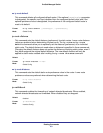
Routing Commands
258
ProSafe Managed Switch
A “T” flag appended to a route indicates that it is an ECMP route, but only one of its next hops
has been installed in the forwarding table. The forwarding table might limit the number of
ECMP routes or the number of ECMP groups. When an ECMP route cannot be installed
because such a limit is reached, the route is installed with a single next hop. Such truncated
routes can be identified by a “T” after the interface name.
Note: If you use the connected keyword for <protocol>, the all
option is not available because there are no best or non-best
connected routes.
The show ip route command displays the routing tables in the following format:
Code IP-Address/Mask [Preference/Metric] via Next-Hop, Route-Timestamp, Interface
The columns for the routing table display the following information:
Code
IP-Address/Mask
Preference
Metric
via Next-Hop
Route-Timestamp
• Days:Hours:Minutes if days > = 1
• Hours:Minutes:Seconds if days < 1
Interface
To administratively control the traffic destined to a particular network and prevent it from
being forwarded through the router, you can configure a static reject route on the router. Such
traffic would be discarded and the ICMP destination unreachable message is sent back to the
Format show ip route [{<ip-address> [<protocol>] | {<ip-address> <mask>
[longer-prefixes] [<protocol>] | <protocol>} [all] | all}]
Modes
• Privileged EXEC
• User EXEC
Term Definition
Route Codes
The key for the routing protocol codes that might appear in the routing table output.
Term Definition
The codes for the routing protocols that created the routes.
The IP-Address and mask of the destination network corresponding to this route.
The administrative distance associated with this route. Routes with low values are
preferred over routes with higher values.
The cost associated with this route.
The outgoing router IP address to use when forwarding traffic to the next router (if any)
in the path toward the destination.
The last updated time for dynamic routes. The format of Route-Timestamp will be
The outgoing router interface to use when forwarding traffic to the next destination. For
reject routes, the next hop interface would be Null0 interface.


















